Crossref Citations
This article has been cited by the following publications. This list is generated based on data provided by Crossref.
Drasgow, Fritz
Chernyshenko, Oleksandr S.
and
Stark, Stephen
2010.
Improving the Measurement of Psychological Variables: Ideal Point Models Rock!.
Industrial and Organizational Psychology,
Vol. 3,
Issue. 4,
p.
515.
Park, DongGun
Choi, MyungOk
Lee, WonSun
Lee, HyeMin
and
Lee, JunHee
2012.
Comparison between dominance process model and ideal point response model for personality assesment.
Korean Journal of Industrial and Organizational Psychology,
Vol. 25,
Issue. 2,
p.
421.



